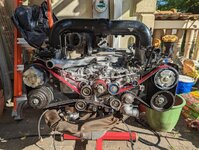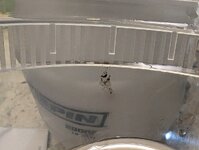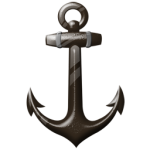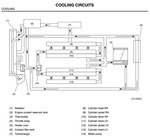All pistons expand with heat and return to size at low temps.Forged pistons do shrink (cold) and swell (hot) but if you got that many years (17) it doesn’t matter to that configuration.
Concentrate on the specific oil required and drive easily until full operating temp. Then let her rip…
You are using an out of date browser. It may not display this or other websites correctly.
You should upgrade or use an alternative browser.
You should upgrade or use an alternative browser.
Improving Forged Engine Longevity w. Coolant Pre-heaters (i.e. Webasto, Eberspächer)
- Thread starter Enlight
- Start date
Enlight
Thread starter
It's been 6 months since I've last logged on, but I've been deep in long block assembly and am aiming to put the engine back in this weekend. I have a break-in tune with Vinny Ten Racing scheduled for next Tuesday, afterwards I hope to share regular oil analyses to answer the original topic of this thread. Right now I have a 400w block heater installed in case I'm unable to figure out the plumbing and wiring of my Eberspächer S3 in time for the tune. I would love to be able to show UOA's from an engine that never had a cold start, but I also hate to be a pain to my tuner. I will at least warm the engine before I trailer her over to them (40 minutes away).
In the meantime, here are some pictures to keep all of you entertained. Don't mind the intake manifold that was installed backwards. If the block looks a little glossy that's because it is, I applied several coats of KBS Diamond Coat. I also flushed my turbo before I reinstalled it and have some photos of what came out.
In the meantime, here are some pictures to keep all of you entertained. Don't mind the intake manifold that was installed backwards. If the block looks a little glossy that's because it is, I applied several coats of KBS Diamond Coat. I also flushed my turbo before I reinstalled it and have some photos of what came out.
Attachments
Piston engine airplanes. It's common to use a pre-heater anytime below freezing. A lot of them are still carbed and magnetos have fixed timing. Combine this with straight 50 grade oils and your chance of a successful start in the teens or 20s without a preheat is pretty low.The only time I've ever read about pre-heaters is with F1 because the tolerances are so tight. I can't imagine how any other engine would benefit. There are plenty of high power engines with forged internals which have no need for this complexity.
Forgot to also mention that most piston engine carbs are updraft aka installed upside down and there is no choke, so you have that to contend with as well.
Even with 15w50 oils, preheat is a book reqirement in the POH for many airplanes, even ones with fuel injection.
[edit] and fuel injection on certified Lycomings and Continentals is always mechanical FI, which comes with it's own set of issues - vapor lock when hot is a real thing with the metal FI tubes, and the starting procedures are only slightly less crude than carbs (run the boost pump for 3 seconds before cold starts, etc). Some mechanical FI engines have a primer instead of running the boost pump to put gas in the cylinders.
You can only use EFI if you're in the experimental category, for the most part. There are experimental category EFI and electronic ignition for traditional engines. Rotax is an exception, they're a little more modern than the others. There's the (yet additonal) complication of closed loop mode being impossible with 100LL leaded fuel. You can use "MOgas" unleaded gas but it doesn't have same level of on-field availability as does 100LL.
Private aviation is way behind car engine technology...now you can see why preheating is a thing. FWIW, Lycoming just released their first fully electronic engine model, the IE2, no magnetos. I think it still has mechanical injection though. Could be wrong about that.
Last edited:
Because they have diesels and it gets down to -30C in Northern Europe. What you're talking about is a use case more like an RV, if you're sleeping in your car. RVs get these for diesel preheat and for practical use in cold climates, e.g., can't have the black water tank freezing up, that would stink. There's usually a separate heater for the actual inside space, a Webasto is used more for heating the storage bays and engine.Interestingly, when I browse European eBay I see that these units come from the factory for economy cars like the VW Golf. In either case, this is just an idea that interests me.
Enlight
Thread starter
First UOA with the new engine block. I haven't installed my coolant pre-heater yet but have been using a regular block heater. I'm usually able to read about 95f at the top of the block before startup. This is 50 miles into the break-in, using Motul 5w-40 Break-in Oil.
Attachments
You may want to consider installing an oil pan heater as well.
Coolant is only part of the fluid equation in an engine.
I have used the Wolverine's quite a bit on commercial fleet.
Sample:
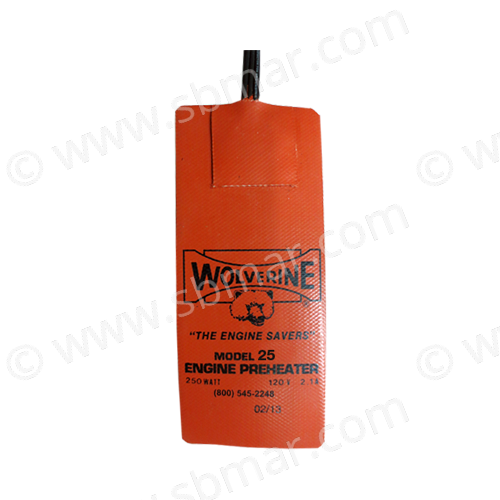
They peel and stick and edges are sealed with included RTV sealant.
As for the block heater, are you using 2, one for each cylinder bank?
PS. My go to for 100% winter starts was factory block heater, oil pan heater pad and battery tender, all plumbed into a 120v shore plug on the box truck corner, nearest the driver's door.
Total wattage pulled was about 1000 watts.
Coolant is only part of the fluid equation in an engine.
I have used the Wolverine's quite a bit on commercial fleet.
Sample:

They peel and stick and edges are sealed with included RTV sealant.
As for the block heater, are you using 2, one for each cylinder bank?
PS. My go to for 100% winter starts was factory block heater, oil pan heater pad and battery tender, all plumbed into a 120v shore plug on the box truck corner, nearest the driver's door.
Total wattage pulled was about 1000 watts.
Use 2 freeze plug heaters. That's what I did. Would make an old Chevy 6.5 diesel so a temperature gauge reading on a freezing cold day. On a tiny 4 cylinder engine it would probably work a lot better.
Enlight
Thread starter
Cool! Good luck with the eberspacher heater, I have one that I got to run by bypassing all the computer controls and manually running the fuel pump. Boils 1/2 gallon of water in about 2 minutes.
Thank you. Between the wiring, finding a location for the heater, and drilling a hole in the tank I'm dreading the install a little bit. I've also got a rough idle right now and hope I don't have to tear apart the entire fueling system to figure it out. The car has a Fluidampr and I dynamically balanced the flywheel. It should be a lot smoother.
You may want to consider installing an oil pan heater as well.
Coolant is only part of the fluid equation in an engine.
...
As for the block heater, are you using 2, one for each cylinder bank?
Use 2 freeze plug heaters. That's what I did. Would make an old Chevy 6.5 diesel so a temperature gauge reading on a freezing cold day. On a tiny 4 cylinder engine it would probably work a lot better.
I did consider the oil pan heater as well and I'm not ruling it out completely. In the interim, I might try pointing the exhaust of the coolant heater towards the oil pan to see whether that makes a difference. IIRC, the EJ25 did not have coolant plugs on either side of the boxer engine, the one I installed was somewhere in the bottom-middle towards the driver side. I also didn't want to have to worry about tripping any breakers as I use this car for road trips. The current freeze plug was actually just a holdover for until I figured out the Eberspaecher.
If one had to choose between a block or oil pan heater, it looks like the block heater would do a better job of closing up pre-start tolerances and helping atomization/cold starts. Here's a YouTube video on the topic:
Last edited:
Enlight
Thread starter
I plan on installing my coolant pre-heater in the near future and am considering which hoses to tap for the feed and return. The main idea is for the coolant to take the longest path it can in order to heat as much of the block as possible.
Would the water pump actually impede the flow of the heater since the engine won't be running?
Would the water pump actually impede the flow of the heater since the engine won't be running?
Attachments
Because it's a Subaru?Why? Makes no sense to replace the engine on a 17 year old Subaru unless this is a pristine low mileage example. But then, why would it need an engine?
Enlight
Thread starter
It occurred to me that installing the feed/returns on either side of an inline thermostat might be ideal. That should definitely create the longest path and save me the trouble of finding the longest path between two points on the engine.
Enlight
Thread starter
Merry Christmas all!
Had a quiet day today after last night's big family and friends dinner so I started work on installing the pre-heater. I chose to mount the heater on the driver-side front frame rail, probably the last part of the car that needs more weight. The heater itself is a hair under 5 lbs.

I welded one side of the included bracket to the frame rail. Not quite "stacking dimes," the welds are pretty ugly.

On the other side, I tapped an M6x1.0mm hole.

I then bolted up the right side with a standoff and ground down the welds. I used an induction heater to heat up the bracket and gave it a few love taps with a hammer. This was to take some stress out of it. I gave it a good shake - it was able to move the rest of the car.

Here she is mounted up. Next steps will be to tap the fuel pump housing and run the fuel supply line.
Had a quiet day today after last night's big family and friends dinner so I started work on installing the pre-heater. I chose to mount the heater on the driver-side front frame rail, probably the last part of the car that needs more weight. The heater itself is a hair under 5 lbs.

I welded one side of the included bracket to the frame rail. Not quite "stacking dimes," the welds are pretty ugly.

On the other side, I tapped an M6x1.0mm hole.

I then bolted up the right side with a standoff and ground down the welds. I used an induction heater to heat up the bracket and gave it a few love taps with a hammer. This was to take some stress out of it. I gave it a good shake - it was able to move the rest of the car.

Here she is mounted up. Next steps will be to tap the fuel pump housing and run the fuel supply line.
Enlight
Thread starter
Proposed coolant path

So it will take coolant from the radiator and pump it through a heater hose, through the engine, and back through the radiator?Proposed coolant path
View attachment 195085
Enlight
Thread starter
That's right, the supply and return of the hydronic heater are essentially on either side of the engine block's thermostat, resulting in the longest circuit possible. The OEM thermostat begins to open at 194f and the hydronic heater outputs at a max of 185f. If everything is working properly, the heater should never open that valve.So it will take coolant from the radiator and pump it through a heater hose, through the engine, and back through the radiator?
The Eberspacher manual recommends tapping the supply and return between the two farthest points. Even if you tap on the opposite ends of the engine, it will won't be as long as tapping either side of a thermostat. The long circuit is ideal in this application since it will warm the block the most thoroughly.
There is an added benefit in this engine, and that is there is an oil/coolant heat exchange. The hydronic heater will help to preheat some of the oil, though unfortunately not the pan itself.
The only problem I can see with your plan is the radiator will cool down the coolant that's returning to the heater. I would cut the radiator out of the loop for maximum heating of the engine.That's right, the supply and return of the hydronic heater are essentially on either side of the engine block's thermostat, resulting in the longest circuit possible. The OEM thermostat begins to open at 194f and the hydronic heater outputs at a max of 185f. If everything is working properly, the heater should never open that valve.
The Eberspacher manual recommends tapping the supply and return between the two farthest points. Even if you tap on the opposite ends of the engine, it will won't be as long as tapping either side of a thermostat. The long circuit is ideal in this application since it will warm the block the most thoroughly.
There is an added benefit in this engine, and that is there is an oil/coolant heat exchange. The hydronic heater will help to preheat some of the oil, though unfortunately not the pan itself.
Enlight
Thread starter
The only problem I can see with your plan is the radiator will cool down the coolant that's returning to the heater. I would cut the radiator out of the loop for maximum heating of the engine.
That's a really good point, thanks for that. If I tap from the upper radiator coolant hose instead of the bottom I should be able to avoid that problem.
Enlight
Thread starter
The latest UOA.

Similar threads
- Replies
- 96
- Views
- 19K
- Replies
- 14
- Views
- 18K
- Replies
- 9
- Views
- 7K
- Locked
- Replies
- 31
- Views
- 11K

